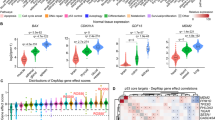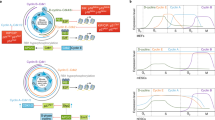Abstract
p53 is an important regulator of normal cell response to stress and frequently mutated in human tumours. Here, we studied the effects of activation of p53 and its target gene p21 in human embryonic stem cells. We show that activation of p53 with small-molecule activator nutlin leads to rapid differentiation of stem cells evidenced by changes in cell morphology and adhesion, expression of cell-specific markers for primitive endoderm and trophectoderm lineages and loss of pluripotency markers. p21 is quickly and dose-dependently activated by nutlin. It can also be activated independently from p53 by sodium butyrate, which leads to the differentiation events very similar to the ones induced by p53. During differentiation, the activating phosphorylation site of CDK2 Thr-160 becomes dephosphorylated and cyclins A and E become degraded. The target for CDK2 kinase in p53 molecule, Ser-315, also becomes dephosphorylated. We conclude that the main mechanism responsible for differentiation of human stem cells by p53 is abolition of S-phase entry and subsequent stop of cell cycle in G0/G1 phase accompanied by p21 activation.
This is a preview of subscription content, access via your institution
Access options
Subscribe to this journal
Receive 50 print issues and online access
$259.00 per year
only $5.18 per issue
Buy this article
- Purchase on Springer Link
- Instant access to full article PDF
Prices may be subject to local taxes which are calculated during checkout









Similar content being viewed by others
References
Cheng T, Rodrigues N, Shen H, Yang Y, Dombkowski D, Sykes M et al. (2000). Hematopoietic stem cell quiescence maintained by p21cip1/waf1. Science 287: 1804–1808.
Dontu G, Jackson KW, McNicholas E, Kawamura MJ, Abdallah WM, Wicha MS . (2004). Role of Notch signaling in cell-fate determination of human mammary stem/progenitor cells. Breast Cancer Res 6: R605–R615.
Dravid G, Ye Z, Hammond H, Chen G, Pyle A, Donovan P et al. (2005). Defining the role of Wnt/beta-catenin signaling in the survival, proliferation, and self-renewal of human embryonic stem cells. Stem Cells 23: 1489–1501.
Gartel AL, Radhakrishnan SK . (2005). Lost in transcription: p21 repression, mechanisms, and consequences. Cancer Res 65: 3980–3985.
Groszer M, Erickson R, Scripture-Adams DD, Lesche R, Trumpp A, Zack JA et al. (2001). Negative regulation of neural stem/progenitor cell proliferation by the Pten tumor suppressor gene in vivo. Science 294: 2186–2189.
Hainaut P, Hollstein M . (2000). p53 and human cancer: the first ten thousand mutations. Adv Cancer Res 77: 81–137.
Hock H, Hamblen MJ, Rooke HM, Schindler JW, Saleque S, Fujiwara Y et al. (2004). Gfi-1 restricts proliferation and preserves functional integrity of haematopoietic stem cells. Nature 431: 1002–1007.
Hyslop L, Stojkovic M, Armstrong L, Walter T, Stojkovic P, Przyborski S et al. (2005a). Downregulation of NANOG induces differentiation of human embryonic stem cells to extraembryonic lineages. Stem Cells 23: 1035–1043.
Hyslop LA, Armstrong L, Stojkovic M, Lako M . (2005b). Human embryonic stem cells: biology and clinical implications. Expert Rev Mol Med 7: 1–21.
Joers A, Kristjuhan A, Kadaja L, Maimets T . (1998). Tumour associated mutants of p53 can inhibit transcriptional activity of p53 without heterooligomerization. Oncogene 17: 2351–2358.
Kippin TE, Martens DJ, van der Kooy D . (2005). p21 loss compromises the relative quiescence of forebrain stem cell proliferation leading to exhaustion of their proliferation capacity. Genes Dev 19: 756–767.
Lane DP . (1992). p53, the guardian of the genome. Nature 358: 15–16.
Lin T, Chao C, Saito S, Mazur SJ, Murphy ME, Appella E et al. (2005). p53 induces differentiation of mouse embryonic stem cells by suppressing Nanog expression. Nat Cell Biol 7: 165–171.
Liu M, Iavarone A, Freedman LP . (1996b). Transcriptional activation of the human p21(WAF1/CIP1) gene by retinoic acid receptor. Correlation with retinoid induction of U937 cell differentiation. J Biol Chem 271: 31723–31728.
Liu M, Lee MH, Cohen M, Bommakanti M, Freedman LP . (1996a). Transcriptional activation of the Cdk inhibitor p21 by vitamin D3 leads to the induced differentiation of the myelomonocytic cell line U937. Genes Dev 10: 142–153.
Meletis K, Wirta V, Hede SM, Nister M, Lundeberg J, Frisen J . (2006). p53 suppresses the self-renewal of adult neural stem cells. Development 133: 363–369.
Molofsky AV, Pardal R, Iwashita T, Park IK, Clarke MF, Morrison SJ . (2003). Bmi-1 dependence distinguishes neural stem cell self-renewal from progenitor proliferation. Nature 425: 962–967.
Nakano K, Mizuno T, Sowa Y, Orita T, Yoshino T, Okuyama Y et al. (1997). Butyrate activates the WAF1/Cip1 gene promoter through Sp1 sites in a p53-negative human colon cancer cell line. J Biol Chem 272: 22199–22206.
Qin H, Yu T, Qing T, Liu Y, Zhao Y, Cai J et al. (2007). Regulation of apoptosis and differentiation by p53 in human embryonic stem cells. J Biol Chem 282: 5842–5852.
Stojkovic M, Lako M, Stojkovic P, Stewart R, Przyborski S, Armstrong L et al. (2004). Derivation of human embryonic stem cells from day-8 blastocysts recovered after three-step in vitro culture. Stem Cells 22: 790–797.
Tanaka M, Herr W . (1990). Differential transcriptional activation by Oct-1 and Oct-2: interdependent activation domains induce Oct-2 phosphorylation. Cell 60: 75–86.
Tovar C, Rosinski J, Filipovic Z, Higgins B, Kolinsky K, Hilton H et al. (2006). Small-molecule MDM2 antagonists reveal aberrant p53 signaling in cancer: implications for therapy. Proc Natl Acad Sci USA 103: 1888–1893.
Tyner SD, Venkatachalam S, Choi J, Jones S, Ghebranious N, Igelmann H et al. (2002). p53 mutant mice that display early ageing-associated phenotypes. Nature 415: 45–53.
Vassilev LT, Vu BT, Graves B, Carvajal D, Podlaski F, Filipovic Z et al. (2004). In vivo activation of the p53 pathway by small-molecule antagonists of MDM2. Science 303: 844–848.
Vousden KH, Lu X . (2002). Live or let die: the cell's response to p53. Nat Rev Cancer 2: 594–604.
Wei CL, Wu Q, Vega VB, Chiu KP, Ng P, Zhang T . (2006). A global map of p53 transcription-factor binding sites in the human genome. Cell 124: 207–219.
Wicha MS, Liu S, Dontu G . (2006). Cancer stem cells: an old idea—a paradigm shift. Cancer Res 66: 1883–1890.
Acknowledgements
We thank Ian Dimmick for help in flow cytometry and Stuart Atkinson for assistance with Quantitative real-time-PCR. This work has been supported by grants from Estonian Science Foundation (ETF6459) and Citrina Foundation (TM) and One North East Regional Developmental Agency (ML).
Author information
Authors and Affiliations
Corresponding author
Rights and permissions
About this article
Cite this article
Maimets, T., Neganova, I., Armstrong, L. et al. Activation of p53 by nutlin leads to rapid differentiation of human embryonic stem cells. Oncogene 27, 5277–5287 (2008). https://doi.org/10.1038/onc.2008.166
Received:
Revised:
Accepted:
Published:
Issue Date:
DOI: https://doi.org/10.1038/onc.2008.166
Keywords
This article is cited by
-
Activation of AMPK promotes cardiac differentiation by stimulating the autophagy pathway
Journal of Cell Communication and Signaling (2023)
-
Follistatin supplementation induces changes in CDX2 CpG methylation and improves in vitro development of bovine SCNT preimplantation embryos
Reproductive Biology and Endocrinology (2021)
-
The role of SIRT5 and p53 proteins in the sensitivity of colon cancer cells to chemotherapeutic agent 5-Fluorouracil
Molecular Biology Reports (2021)
-
Deletion of Nrip1 delays skin aging by reducing adipose-derived mesenchymal stem cells (ADMSCs) senescence, and maintaining ADMSCs quiescence
GeroScience (2021)
-
CDK9 activity is critical for maintaining MDM4 overexpression in tumor cells
Cell Death & Disease (2020)



